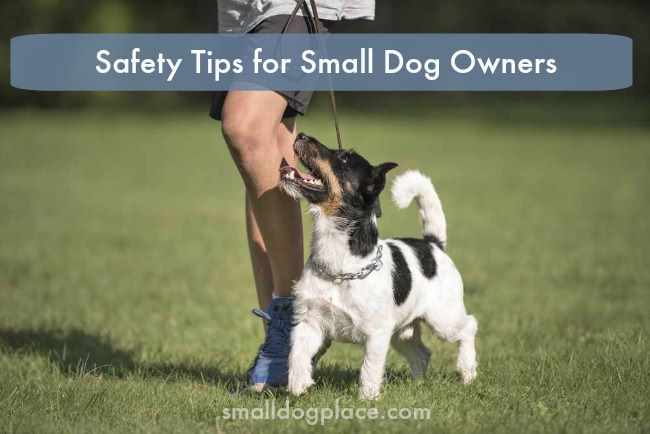- Small Dog Place Home
- Safety
- Safety Tips for Dog Owners
6 Safety Tips for Dog Owners
Safety Tips for Dog Owners
Owning a dog is both a testing and rewarding experience, and half the battle is keeping the little four-legged creatures out of harm’s way.
We all love our dogs and would hate to see anything bad happen to them, so it is important to eliminate the risks that day-to-day life present to our furry friends.
Safety Tips for Dog Owners
Here are a few tips to help you keep your little furbaby safe.
1. Training
First thing’s first and when bringing a new dog home it is important to train them properly.
While getting the dog house trained is important to keep your carpets in a usable state, ensuring that your new pet answers to commands will go a long way in keeping them safe.
When your dog is outside, even if it is just in the garden, they must be able to respond to commands – even if this is just to answer to their name and come back to you, stopping anything that they are doing.
The last thing that you want is for a small dog to bolt out of an open door and risk running into the middle of a busy road and being run over by a car.
This can be stopped by the dog responding to a command, or simply being taught to stay and wait at the door until told otherwise.
Training your dog can be made easier by offering incentives to reward good behaviour, such as small treats and toys.
Rewarding your dog when they have done well and will encourage them to remain focused on you and repeat their behaviour.
2. Keep Them In Sight: Supervise!
As the owner of a dog, especially a small dog, it is important to keep them in sight when heading out as there are dangers all around.
Although many owners can often be seen trusting their dog off the lead when walking on paths, this can be hazardous, particularly when walking close to a road with cars driving past with not enough time to stop should a dog suddenly run out in front of them.
Another reason your dog must be kept both in sight and on a lead is due to the sad fact that smaller dogs are targeted by thieves. In England and Wales alone, reports of dog thefts have increased by 22% over the last two years.
Thieves target smaller dogs, particularly toy-designer breeds such as Pugs and miniature French Bulldogs, as they are worth more money.
Thieves will generally target bitches as they can breed them with studs and make even more money from the dog.
Another reason that thieves target smaller breeds of dogs is, unfortunately, to use them as bait for fighting dogs.
3. Microchip and Other Means of Identification
It has now been made law in the UK for all dogs to be microchipped, meaning that the dog can be traced back to their owner with a simple scan.
However, it has not been made compulsory for a vet to carry out these scans when they come into surgery, meaning that stolen dogs can potentially slip through the system.
If your dog does go missing, ensuring that they have a tag on their collar with a name and contact number will help whoever finds them to reunite you with your dog.
In one study, it was found that 93% of dogs reported lost were returned safety to their home, with 15% crediting identification tags and/or microchipping.
4. Be Wary Around Bigger Dogs
Many smaller dogs have a tendency to act larger than they actually are – small dog syndrome – and may look towards bigger dogs.
More often than not this is in a playful manner; however if the larger dog takes a disliking to your more pint-sized friends, the end result may not be to your liking.
It must be said that this is highly unlikely to happen, especially if you have properly trained your small dog, but you do not know how well trained stranger dogs have been trained – it is best to think safety first.
Keep a safe distance between your dog and others if you feel that there is a potential danger and bear in mind the traits of other breeds.
5. Check the Garden for Small Holes
If there is something to be found, you can guarantee a small dog will find it.
If there is a small gap potentially leading to a neighbour’s back garden be prepared for a knock on the door alerting you that your dog has crossed the boundary.
Before bringing home a new dog, especially if it is your first, take the time to check the garden for any potentially gaps in the fencing that a small dog could get through.
It may also be worth ensuring that there is no chance of the dog digging underneath the fence and working an opening.
Puppy-proof your home and eradicate any potentials hazards that your new small friend can find.
They are bound to get into mischief and find something that you may have missed, but minimising the risks will go a long way to safeguarding your dog.
6. Keep your Home Free of Insects and Germs
Not only will this help to keep your dog safe and healthy, but it will also keep you safe and healthy as well.
The most common insect problem associated with dogs is fleas – if you do not treat this immediately, they will soon start to bite you, too.
Keep your dog clean and treated with anti-flea products when fleas make an appearance.
It is also important to change your bedding, especially if your dog is allowed on your bed, and to thoroughly clean all other furniture in the house.
Not only can insects irritate your dog they can also carry potentially harmful diseases. Keep all areas that your dog goes to clean and tidy as insects and rodents will thrive in filthy spaces.
About Janice (author and voice behind this site)
Janice Jones has lived with dogs and cats for most of her life and worked as a veterinary technician for over a decade. She has also been a small-breed dog breeder and rescue advocate and holds academic training in psychology, biology, nursing, and mental health counseling. Her work focuses on helping dog owners make informed, responsible decisions rooted in experience, education, and compassion.
When not writing, reading, or researching dog-related topics, she likes to spend time with her six Shih Tzu dogs, her husband, and her family, as well as knitting and crocheting. She is also the voice behind Miracle Shih Tzu and Smart-Knit-Crocheting
Does This Article Deserve Your Thumbs Up?
We always appreciate your support and encouragement. Your thumbs up means so much to us. Please like this article.
If you find this page or any page on Small Dog Place Helpful, or useful in anyway, I'd love it if you would click the small heart found on the bottom right of each page.
You can also share or bookmark this page -- just click on the:

Free Monthly Newsletter
Sign Up for Our Free Newsletter and get our Free Gift to You.
my E-book, The Top 10 Mistakes People Make When Choosing a Dog (and how to avoid them)





